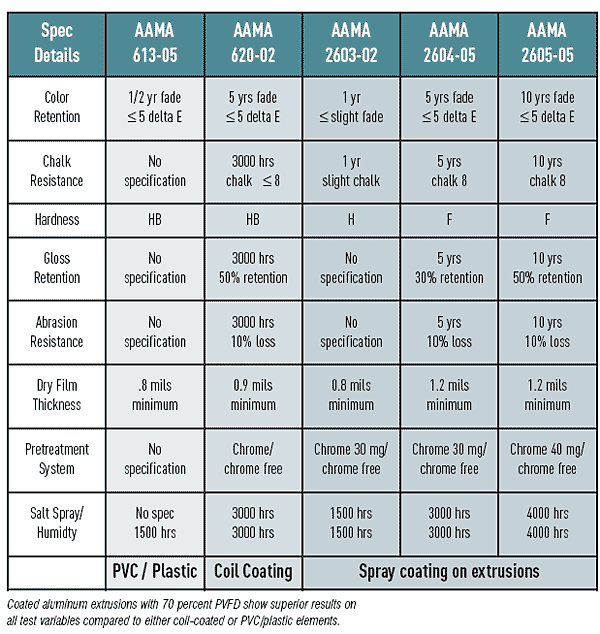AAMA 2605-05 Sets High Standards for Coated Aluminum Extrusions and Panels
AAMA 2605-05: The Highest Standard in the Industry
In accordance with standards, aluminum extrusions or panels must undergo a surface preparation for a PVDF coating application that involves the following steps:
- Acid or alkaline wash to remove impurities
- A fresh water rinse
- Chemical conversion-a chromium or non-chromium pretreatment. This is a process that treats the metal surface chemically when the metal is immersed in or sprayed with various solutions. The finish provides good protection and adhesion; it is typically used as a base for another, final finish.
- Ambient fresh water rinse
To adhere to the AAMA 2605-05 standards, properly prepared test panels are subjected to the following rigorous tests:
Color uniformity. Random samples are checked usually under a uniform light source from various angles and by instrumental methods.
Requirement:Color uniformity must be consistent with color range or numerical value established between the approval source and the applicator.
Specular gloss. Gloss consistency is tested from one unit to another. A 60-degree gloss meter measures newly finished aluminum for a gloss value.
Requirement:Gloss values must be within five units of the manufacturer's specification.
Dry film hardness. (The term film is used interchangeably with coating.) This is a test for susceptibility to damage that might be sustained during shipping or installation. A tester pushes a pencil with F (medium) hardness held at a 45-degree angle into the film and tries to rupture it.
Requirement: Film does not rupture.
|
Film Adhesion. This is a test for a coating lifting off the substrate. This test is conducted in three categories:
Dry Film Adhesion: Tape is scored in a prescribed cross hatch pattern and adhered to a sample, and then sharply pulled off at a right angle to the plane being tested.
Wet Film Adhesion: The panel with tape over the cross hatch patterns should be immersed in distilled or de-ionized water at 100 degrees F for 24 hours. The sample panel should then be removed and wiped dry, after which the film adhesion test is repeated.
Boiling Water Film Adhesion: The sample panel is immersed in boiling water for 20 minutes. The water remains boiling for the full 20-minute test period. The sample is removed and wiped dry and the adhesion test is repeated.
Requirement: For all tests, there should be no removal of coating under the tape either within or outside the cross hatched area, nor blistering anywhere on the test specimen. Paint that lifts off is measured as a percentage failure rate.
Impact resistance.This tests whether the coating will rupture after impact. A tester drop dart impacts the surface in order to deform a small piece of the sample. Tape is applied over the deformed area and sharply removed at a right angle to the panel.
Requirement: No removal of the coating from the substrate.
Abrasion resistance. This tests the number of years a product is likely to resist wearing off. Sand is filtered through a funnel until it wears through the top coat.
Requirement: The amount of sand falling onto the test sample without wearing through the surface must be within calculated parameters.










